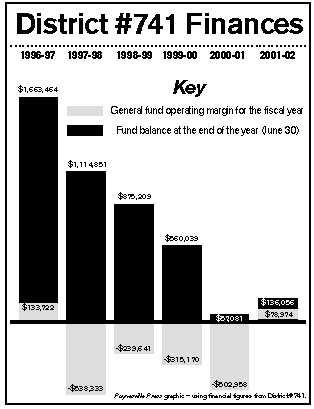Good news: District runs in the black
The district's general fund operated on a positive margin of $78,974 for the 2001-02 school year, which, for fiscal purposes, ended on June 30. The district's general fund received $8.52 million in revenue in 2001-02 while accruing $8.44 million in expenses.
(If all school funds are included, the district's budget totals just over $10 million.)
The local school district last operated in the black for a school year in 1996-97, when the district's fund balance reached $1.6 million. It now stands at $136,056, up from $57,081 a year ago.
 After the audit a year ago, the district learned that it qualified for statutory operating debt, according to criteria set by the state, namely having debt in the district's unreserved general fund of 2.5 percent of the general fund budget. This time, the audit showed that the district no longer qualifies for statutory operating debt, as its unreserved fund deficit is now only $128,695, which is less than two percent of its budget.
After the audit a year ago, the district learned that it qualified for statutory operating debt, according to criteria set by the state, namely having debt in the district's unreserved general fund of 2.5 percent of the general fund budget. This time, the audit showed that the district no longer qualifies for statutory operating debt, as its unreserved fund deficit is now only $128,695, which is less than two percent of its budget.
However, warned Al Habben of Frieler, Habben, and Company, which conducted the district's audit again, the district does have a deficit budget for the current school year (2002-03) and, based on it, the district will be back in SOD next year.
"As you can see, we're making some headway. We're moving forward," superintendent Howard Caldwell told the school board, while cautioning that this year's budget was going to be a struggle.
In recent years, though, the district's bottom line has been better than budgeted. In 2001-02, for instance, the budget predicted a deficit of $279,648, while the actual audited bottom line was a positive $78,974, a variance to the good of over $350,000. (Of this, over $250,000 was additional revenue, and $100,000 was fewer expenditures than budgeted.)
The last budget for 2002-03 - approved by the board in mid-November - predicts a deficit in the general fund of nearly $300,000 for the year. "We are still concerned about this year," said Caldwell, in an interview after the board meeting last week. "Our budget's still tight." Caldwell, wanting only to err on the side of caution, admitted that the current budget is conservative again, with revenues likely underestimated and expenditures overestimated. "We are hopeful in the end to turn out better than it looks right now," he said.
With the district in a better financial situation than expected (as of June 30, 2002) and with an operating levy providing extra revenue to the district starting in 2003-04, the public might be tempted to think that it's time for the district to spend more (including reinstating some of the cuts made the past two years). But Caldwell cautioned that the district still has a minimal fund balance and a deficit in unreserved funds, those that can be spent at the discretion of the school board.
"It's still in a danger zone," said Caldwell. "I don't feel comfortable where we're at."
Since the prime source of district funding comes from the state and is based on student population, the need remains to base the budget on the number of students. With incoming kindergarten classes around 75 and graduating classes around 100, it appears the district will continue to face declining enrollment in coming years. Next year, Caldwell estimates a loss of 25 to 30 students. At $5,000 per student in aid, this figures out to be a loss to the budget of $150,000. The school board last week also authorized the administration to look at the budget and recommend adjustments. With the voter-approved operating levy taking effect in 2003-04, some cut items may be reinstated, but Caldwell stressed the need to remain vigilant in restoring the district to financial health. That means administration will also look for ways to reduce expenditures, especially as the needs of the students change.
For example, in this school year, administration was able to cut teaching time in art in the high school, due to a decrease in demand from students. They were then able to add time in the music department, which had been approved as a cut. In the end, they reduced the teaching time more than expected, while putting the time in the area demanded by students.
"I think we need to look at what we need and where we want to put our money," said Caldwell.
(Last week, the board also approved a new two-year contract for Caldwell, who announced his intention to resign as superintendent after the 2003-04 school year.)
According to Caldwell, any reinstatements to the budget will be carefully scrutinized for impact on student achievement and cost. "We need to look at what we need. There's a fine line between what we want and what we can afford," he said.
Caldwell expected administrators to get recommendations and ideas for budget adjustments from each building by the end of December, for administration to discuss these options and develop a play in January, and to present their budget adjustment proposals to the school board in February. "Hopefully we'll come up with something our school board can support after we've done our homework," he said.
While it is not clear whether the district still is obligated to follow its Statutory Operating Debt plan, which was submitted and approved by the state, Caldwell thinks the district should keep it in mind, especially the goal to have an eight percent budget balance.
Contact the author at editor@paynesvillepress.com • Return to News Menu
Home | Marketplace | Community